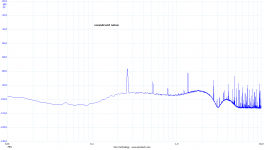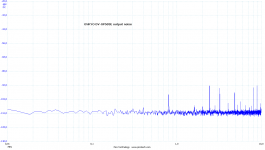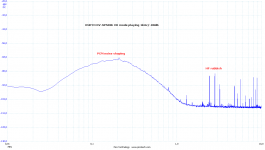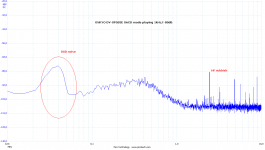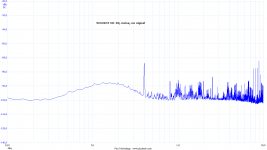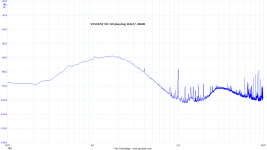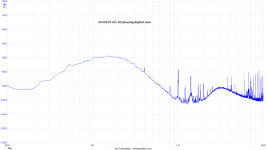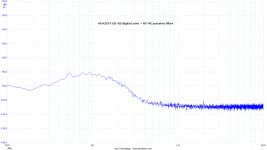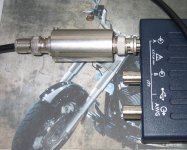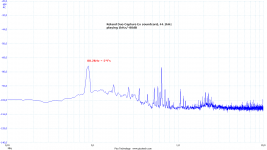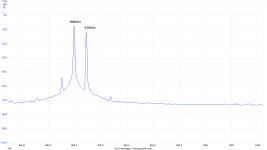Well, I was surprised to see so many CD and DVD I had access to all with HF at significant levels to be a serious concern to analog amps which follow. This older mastering machine is no exception. But as I look around I find in the literature sevral expensive makes and model which have G-D correction built in. But I do not know if they have significant HF on their outputs.
Just an interesting sitaution that never should have been allowed to happen and maybe overlooked by using 20 or 30 KHz analyzer cut-off filtrs.
I think a 50KHz will work fine on 16/44 or 24/96. I use a 50 on the 16/44.1KHz. It is 5 pole only. Because I did not install it in the CD machine, I can use it on any machine.
I had already said Bessel earlier, BTW. I dont think it has much affect at all on the 16/44khz system < 20KHz. .
THx-RNMarsh
Just an interesting sitaution that never should have been allowed to happen and maybe overlooked by using 20 or 30 KHz analyzer cut-off filtrs.
I think a 50KHz will work fine on 16/44 or 24/96. I use a 50 on the 16/44.1KHz. It is 5 pole only. Because I did not install it in the CD machine, I can use it on any machine.
I had already said Bessel earlier, BTW. I dont think it has much affect at all on the 16/44khz system < 20KHz. .
THx-RNMarsh
Last edited:
maybe overlooked by using 20 or 30 KHz analyzer
Two measurements of HF noise with 10MHz bandwidth, soundcard and Onkyo DVD player. Y axis is calibrated, dBV is dBV.
Yes, this cannot be seen with 30kHz analyzer, on the other hand narrow bandwidth is necessary to get resolution for noise and distortion measurement in audio band.
Attachments
Previous images were with DAC playing no signal (muted). The situation that Richard mentioned becomes obvious with signal, when the DAC output is not muted. 1kHz/-80dB signal was played through ONKYO DV-SP503E in CD mode and SACD mode. Measurement starts at 10kHz, so we can see only noise. Note noise shaping in CD mode and DSD filtered noise in SACD mode. CD mode in fact creates more ultrasonic noise for this player.
Attachments
This is Vincent CD-S3 CD player with no signal, playing digital zero and 1kHz/-80dB.
So yes, there is an issue we know about a long time, but e.g. I was not able to make a proper analysis before, because I did not have a suitable instrumentation.
So yes, there is an issue we know about a long time, but e.g. I was not able to make a proper analysis before, because I did not have a suitable instrumentation.
Attachments
It you look for it here, you will also find some of the GD limit numbers mentioned as well. happy hunting.
-RM
"here"? Where is that? There is no link, no mention of any other post, in your post, Richard.
This is Vincent CD-S3 CD player with no signal, playing digital zero and 1kHz/-80dB.
So yes, there is an issue we know about a long time, but e.g. I was not able to make a proper analysis before, because I did not have a suitable instrumentation.
Why should one worry about ultrasonic noise signals whose amplitude is less than a millivolt in the context of normal line levels which are on the order of a volt or more?
Does someone have power amps that are so crappy that they produce audible IM when driven by signals this small and far out of the audio range?
Why should one worry about ultrasonic noise signals whose amplitude is less than a millivolt in the context of normal line levels which are on the order of a volt or more?
Does someone have power amps that are so crappy that they produce audible IM when driven by signals this small and far out of the audio range?
Well, ultrasonic noise is higher in peak amplitude (the spectrum shows only frequency component amplitude at individual frequency) for the ultrasonic noise, i.e. in my measurements it is 20kHz - 1MHz approx. range. It is really "noise". So the Vp is rather in tens of mV. Above 1MHz we can see individual spectral lines of real HF rubbish and then we can quite reliable read the "noise" (not noise >1MHz in fact) amplitude of the MHz interference.
I agree that this should not matter, but IME it is not the case. Some 13 years ago I was quite wondering why there are sound differences between opamps, preamps, you name it. And started to design with respect to HF interferences - and it has helped a lot. Since that time, I have almost no issues with "digital sound", if the recording is good enough. But I did not have measurements good enough, just scope screen (which is not bad, though, only interference quantification is not very exact).
So I agree with you - in case you bear in mind HF interference from the beginning, it should not be a big problem. But it is a problem with many commercial products.
We had another point here, more important, IMO. Close to Fs/2 22kHz reconstruction filters behavior. I am sure that it can create intermodulations not in well designed amplifiers, but in tweeters. Audible intermodulations. And it can be easily proven. I am >60 and do not hear 19kHz, but 1kHz product of 19+20kHz test is audible for everyone and any tweeter always creates it, even if the amplifier has 0.0001% CCIF IMD. So this is the real issue, IMO, not the HF in a well designed component.
Last edited:
Well, ultrasonic noise is higher in peak amplitude (the spectrum shows only frequency component amplitude at individual frequency) for the ultrasonic noise, i.e. in my measurements it is 20kHz - 1MHz approx. range. It is really "noise". So the Vp is rather in tens of mV. Above 1MHz we can see individual spectral lines of real HF rubbish and then we can quite reliable read the "noise" (not noise >1MHz in fact) amplitude of the MHz interference.
One counterpoint is that audio gear, particularly power amps generally has a high frequency roll off above 50 or 100 KHz. Figuring a gentle first order passive filter, response is 20 or more dB down above 1 MHz. So the tens of mV or noise are attenuated back down to the mV range.
I agree that this should not matter, but IME it is not the case. Some 13 years ago I was quite wondering why there are sound differences between opamps, preamps, you name it. And started to design with respect to HF interferences - and it has helped a lot. Since that time, I have almost no issues with "digital sound", if the recording is good enough. But I did not have measurements good enough, just scope screen (which is not bad, though, only interference quantification is not very exact).
Some 41 years ago I was wondering why there were apparent sound differences between opamps, preamps, you name it. I studied up on how listening tests are done properly, and started doing DBTs for important decisions - and it has helped a lot. Since that time, I have no issues with "digital sound", if the recording is good enough.
So I agree with you - in case you bear in mind HF interference from the beginning, it should not be a big problem. But it is a problem with many commercial products.
"Many ommercial products" is vague. I find that most mainstream commercial audio products are well-designed and work together well.
We had another point here, more important, IMO. Close to Fs/2 22kHz reconstruction filters behavior. I am sure that it can create intermodulations not in well designed amplifiers, but in tweeters. Audible intermodulations. And it can be easily proven. I am >60 and do not hear 19kHz, but 1kHz product of 19+20kHz test is audible for everyone and any tweeter always creates it, even if the amplifier has 0.0001% CCIF IMD. So this is the real issue, IMO, not the HF in a well designed component.[/QUOTE]
"I am sure" sounds like faith, not reliable evidence. As others have pointed out, almost all musical recordings have greatly diminished levels at high frequencies because that's how music naturally is.
For example cymbal crashes have most of their energy concentrated around 7-10 Khz, and fall off at 12 dB per octave or more above that.
Last edited:
So I agree with you - in case you bear in mind HF interference from the beginning, it should not be a big problem. But it is a problem with many commercial products.
It would seem natural that someone claiming that this is an issue would be able to demonstrate an effect in the audible band with a normally engineered amp or preamp. When I asked this question previously... no answer. Since you are one of the few actually competent engineers in this discussion, I was hoping you might show at least one simple example.
Stuart, the method is simple in theory, but difficult to get trusted results in real world. It is a HF CCIF intermodulation. I have one generator tuned at about 900kHz and the second one about 910kHz. The amplitude of spectral lines can be made similar as in the measured spectra. The test signal would look like attached. The problem is that one of the generators is too non-linear and difference tone 10kHz is created even by the method itself, not by non-linearity under test. So for a moment, I have to resign, but I will try to improve the method in future. Maybe a hint for Richard to try?
Attachments
Yes I understand, but at the moment I have only my amplifiers that are designed and tested with HF signals, so there is no measurable difference with the method you are suggesting. Already done. But the HF CCIF test seems to be able to give some results, e.g. when swapping opamps. Of course the test signal amplitude would be kept in reasonable values. I have measured dv/dt of output HF content of the CD players to be up to several V/us. So with cheap widely used opamps there might be an issue, if there is not a proper input RC filter.
- Status
- Not open for further replies.
- Home
- Member Areas
- The Lounge
- John Curl's Blowtorch preamplifier part II
